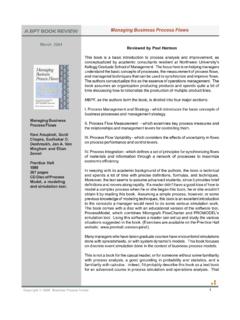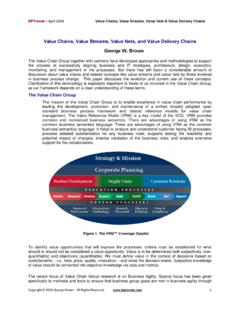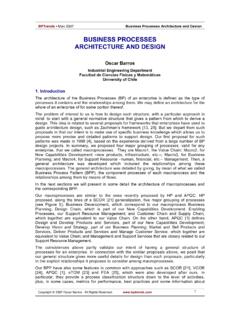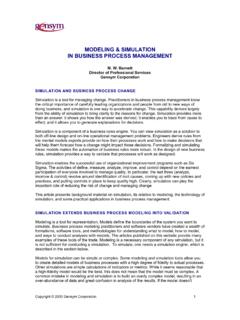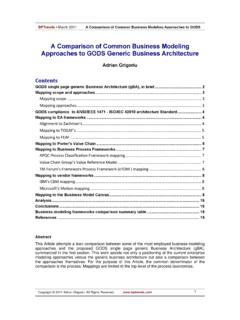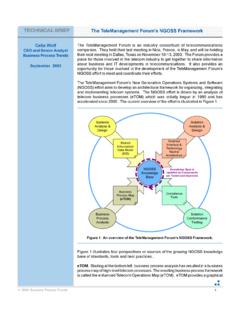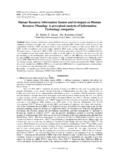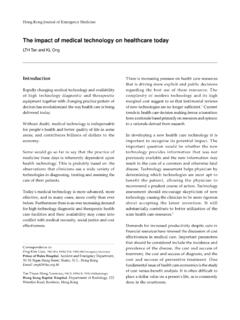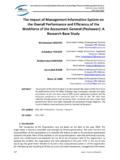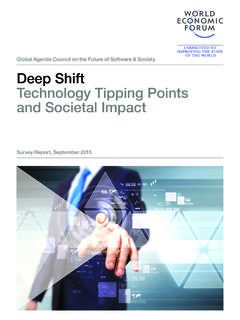Transcription of Human Performance Technology - BPTrends
1 1 Human Performance Technology Donald Tosti Every organization is a Human Performance system: It was founded by people. It s run by people, and It s established to provide value to the people who are its customers/stakeholders. This means that a Human Performance system may be seen as the most fundamental view one can have of any organization. There are other possible views, such as a business view, an operational/process view, or an economic view of the organization. But these viewpoints are all derived from the activities of people. A physician's understanding of the body as, first of all, a biological system is the foundation for dealing with Human health.
2 Similarly, business leaders and managers need an understanding of their organizations as Human Performance systems to establish the foundation for dealing with their organization s success. The universality of HPT derives from the fact that every organization in the world has exactly the same purpose to provide value for its stakeholders. Be it a business, a club, or a government organization all organizations have stakeholders that must be satisfied. Human Performance Technology Let us begin our exploration of HPT by defining Human Performance : Human Performance is the valued result of the work of the people working within a system. And therefore Human Performance Technology consists of those principles and applications that are concerned with improving the impact of any and all factors that affect those results.
3 Consider this definition of Human Performance and what it implies. 1. It emphasizes that we must look at Performance within the context of a system, recognizing the interdependency of the various factors that affect Performance . 2. It recognizes the necessity of looking at people while determining those factors that impact the results that those people produce; in other words, people are at the heart of any analysis we do. 3. It defines Human Performance in terms of results not activity. 4. It focuses on the value of the result, which requires an independent evaluation of the output. This prevents our definition of Human Performance from becoming circular. If we only look at output then whatever is produced defines the Performance .
4 But by requiring an independent receiver to assess the value of the output, we can use that result data to improve the effective functioning of the Human Performance system and its adaptation to its environment. This means that the applications of HPT must start with results and analyze the system components that affect that result. In fact, these provide the first two principles of HPT: Focus on results. Take a systemic view 2 A Human Performance System We said Performance focuses on people working within a system so let us see how we analyze the Performance system. 1. The performer interacts with a physical and social environment that may consist of the necessary tools and equipment, relationships with other people.
5 And so on. We refer to these as the conditions of their environment. They are the givens, the stage settings, the props, and other actors that are available to give support. 2. To initiate any meaningful activity we also need some kind of input or direction. Performers need to know the assignment, the goals, and what is expected of them. 3. On an individual level, we must be sure the performer is able to act (assessing the extent of his or her skills, knowledge, and capacities). 4. The resulting output can be measured, and that information can be used as feedback to the performer about how to change their actions, if need be. 5. Finally, the assessment effort results in some kind of consequence.
6 , and the consequence may be the need to act to motivate or de-motivate people. We refer to this as the motivational or value feedback. These five variables together create a Performance system: The environmental conditions The input /direction The performers ability to act The corrective feedback The motivational consequences Figure 1. A Human Performance System. An HPT Organizational SCAN To analyze a Human Performance system we examine the effects of these five sets of variables to determine what impacts Performance , the results produced by people working within a system 3 The power of HPT is in part derived from the fact that the same Performance system logic can be scaled up to enable us to look at the operations and organizational administrations in a similar way.
7 CONDITIONS INPUT PROCESS OUTCOMES Organizational STRUCTURE Functional divisions Degree of centralization Reporting relationships Decision authority STRATEGY Mission, vision, strategic direction External demands Competitive pressure ADMINISTRATION Administrative systems: flexibility, links, centralization Information systems: timely, accurate, relevant BUSINESS RESULTS Business plan data Marketplace indicators Financial indicators People PRACTICES Leadership practices Hierarchical relationships Peer relationships Business values DIRECTION Priorities Purposes Objectives Assignments PERFORMERS Skill/knowledge Initiative Assignment Selection CONSEQUENCES Performer data Feedback sources/utility Rewards, recognition Expectations Table 1.
8 The Organizational SCAN Putting it all together results in a systems Performance framework a framework that can provide a comprehensive view of the organization as a Human Performance system. By examining the 15 sets of variables in the whole system framework and their interdependencies, the organization can be better understood and much of the mystery about the organization s workings be resolved. In HPT we use Performance system analysis either to design innovative applications that provide new and better ways to achieve results, or to troubleshoot the organization and better align it for success. The third principle of HPT is: Make sure you provide value Over the more than 50 years of the field s development, there have been many breakthrough innovations resulting from the application of HPT.
9 Operations ENVIRONMENT, RESOURCES Equipment, tools, information Support services Accessibility of resources Physical environment DEMANDS, SCHEDULE Requirements (time, quality, cost) Workload Predictability Resources METHODS, CAPACITY Process design Roles and responsibilities Task definition PRODUCTS, SERVICES Product data Standards Timeliness Product mix Level of service /completion 4 One of the first applications was in education and training. The field of Instructional System Design is derived from HPT. Individualized instruction and mastery learning in schools, distance learning, and, most recently, E-learning developments are based on HPT approaches.
10 Other HPT projects have ranged from doing task analysis for USAID community development personnel in Ghana to Performance -based leadership development for the Naval Academy. HPT people developed many of the process improvement and re-engineering techniques in use today. Other examples include Successful organizational culture change was largely pioneered by HPT people working in Europe and the Partnering processes that created internal and external alliances in order to break down the barriers between teams are another successful HPT intervention. Internal brand alignment to assure that people within the company deliver the experience that the company promised is still another example.

